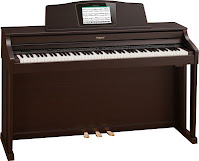 UPDATED REVIEW – January 1, 2018 – Roland HPi-50e Educational Interactive Digital Piano with built-in lessons – RECOMMENDED
UPDATED REVIEW – January 1, 2018 – Roland HPi-50e Educational Interactive Digital Piano with built-in lessons – RECOMMENDED
– As a long time piano teacher, the one major factor which can hinder
students from progressing in their piano lessons (and playing piano in general) is the
amount of time spent practicing at home. Without constant, regular
practice, most piano students are just “spinning their wheels” and
getting no traction when it comes to moving forward in their playing
ability. But how does a parent and/or teacher get a student to practice
regularly at home and hopefully enjoy it too? If you do play, how can you make it more enjoyable? This has always been the
issue, and some people/students will succeed in this area of practice and playing and some
will not. This is true in all things so the more you do something, the better
you will likely get..but it sure helps to like what you are doing and the Roland Hpi50e may be the piano which gets you there:).
The Roland HPi50e is selling for approx $4700-$5000US store selling price and is the latest interactive educational digital piano produced by the Roland piano company and replaces the former HPi50. The HPi50e is upgraded over the previous model primarily in its ability to play and sound more like a real acoustic piano. Although the previous model was quite good, the piano sound and key action upgrades in this model is substantial. The HPi50e is also
designed to do a number of other things including motivating students to
practice more often and more effectively through its built-in
interactive DigiScore technology. The HPi50e is not available for purchase on the
Internet in the US, but only direct at selected Roland piano stores
across the country. The Roland company, which was founded in Japan in
1972, has produced high quality reliable
digital pianos for many years and is recognized as a leader around the
world for digital piano & keyboard technology for professionals
and beginners. I have personally owned and played Roland
pro keyboards and digital pianos and consider them one of the best
brands out there.
The Roland HPi50e is available exclusively in an attractive simulated dark rosewood
finish (and no other colors) with a sturdy matching bench. What makes this
piano unique in the digital piano industry is a number of things
including a very large, easy to read built-in LCD computer monitor built
inside the music rack (the only one of its kind from the major
manufacturers), a vast array of intuitive piano instructional and
practice software and songs accessed by a user friendly control panel
just below the monitor, a full color menu of music lessons, 100’s of
popular play-along songs, auto digital sheet music page turner for sight
reading music, younger & older kids fun interactive music theory
lessons displayed in the large monitor, ensemble music styles for
learning chord progressions and interaction, instant auto lesson
correction telling the student what they did right or wrong displayed in
the LCD monitor, and many other interactive learning and piano playing
features.
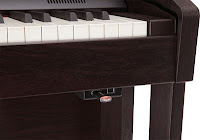
The Roland HPi50e has hundreds of built-in songs for a wide variety of traditional & popular music along with actual
interactive lessons, which definitely help you learn to play and are quite motivational because they allow you to sound good and have fun (and that’s always a good thing). The user can also add their favorite General MIDI format songs
from a USB flash drive and the HPi50e will instantly display the sheet
music from that song. There are literally thousands of these General
MIDI format songs for purchase on the internet from all your favorite
artists and music styles, and some of these songs can be downloaded for
free. Many of the songs will playback the original parts of that song in
a GM (General MIDI) multi-instrument playback mode and you can interact
with it by playing live piano along with the song while you set the
tempo at any speed you desire. It’s like playing piano with a band or
orchestra and seeing the sheet music right in front of you! So whether
you are a basic absolute beginner or are an advanced player, the Roland
Hpi50e is super fun and helps you learn music at the same time. For more
info on General MIDI, please read my review of General MIDI here: General MIDI Review

The Roland company has been producing the HPi series for many years and has had the HPi6, HPi7, HPi6F, HPi7F, and others, and after personally playing this model extensively, I am very impressed with it. For the first time ever in any major brand of digital piano that I know
of, Roland now has 3 electronic key sensors per key along with an additional key scanning processor dedicated to processing key velocity information.
This 4-part electronics
system is
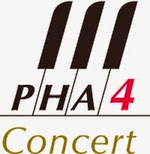
in all of the new Roland DP, HP, & LX models and makes a
huge difference in overall touch sensitivity, dynamic range, and organic piano
tone subtitles and is especially noticeable if you are a more advanced
player. This new key sensor system is a big deal because you can get more powerful expression whether you are playing more softly or with great power pressing on the keys. The new extended tonality and volume range is pretty amazing and yet the soft to loud changes are smooth and even unlike other digital piano brands that I have played, and you’ll definitely notice this. The key weight and static touch weight (amount of finger pressure
required to press keys when keys are at resting position) is also more natural like an acoustic piano should be
as well as balanced from bass through treble range and from black
keys to white keys.
| HPi50e synthetic ebony & ivory keys |
movement using a “let-off/escapement function.” This key movement
simulates the key action feel of a grand piano as opposed to an upright
piano. When you press the keys down
slowly on a real grand piano, you can feel a slight hesitation or notch
about half way down when the key action is moving and this is called the
escapement or let-off effect. Generally speaking, upright acoustic
pianos do not have this feature but grand pianos do. Is this
let-off/escapement feature a necessity for playing a piano?…not
really…but it’s nice to have because it does offer even better playing control especially when playing soft, slow music. The white piano key tops
are coated in a synthetic ivory material which (tries to) duplicates
the feel
of the older acoustic pianos which had real ivory keys and has a slight
textured feeling to them. This synthetic ivory was on the previous
models too. But on these new models Roland has added new synthetic ebony
for the black keys which completes the total realism of playing a real
organic piano keyboard on all keys. This synthetic substance on both
black & white keys
has a slight texture and helps absorb sweat from the fingers and offers a
smoother playing
experience. It also looks a bit classier than the all
shiny white and black keys and I personally like this “feel” very much.
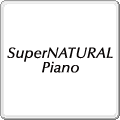
The HPi50e acoustic piano sound is recorded directly in stereo from a Steinway acoustic concert grand
piano. Roland has attempted to reproduce a much more “natural & beautiful” acoustic
stereo piano sound in this model which they call SuperNATURAL Piano along with their 128-note polyphony
piano memory chip (how many notes can be played and sustained at one time). After playing this piano many times I found that the 128-note polyphony memory in this model is more than enough for even the most complex piano pieces because
of Roland’s advanced polyphony voice allocation, even when you are layering and playing two sounds at one time. It’s a fancy way of saying you won’t run out of notes even when playing complex MIDI song files while playing live over the top of it. There are certainly other brands of good digital pianos with great sounding piano tones. But Roland is the only major brand who is using a Steinway concert grand piano sample with the 4-sensor key
response and this is unique in giving the player a piano tone not found in any other top name digital pianos in this price range.

With regard to the piano pedals, they operate very smoothly and feel
realistic to press down while incorporating the three traditional pedal
functions
(damper/sustain, sostenuto, and soft) of regular acoustic pianos. They
do work better than other digital pianos I have played and also simulate
a
good note sustaining experience using a damper continuous detection pedaling
feature. This function gives the player incremental note sustain
amounts rather than just on & off or basic half pedal. It is definitely a
much more realistic acoustic piano playing experience than other brands
as well as
physically feeling like the pedal is changing resistance when being
pressed down. Roland calls this feature Progressive Damper Action.
Having quality piano pedals & accurate piano pedal operation is
very important, especially to more advanced players. Roland does not
skimp on this area of piano playing like some other digital piano
manufacturers do. Even the height of the pedals (an important aspect of
pedal playing) is
accurate as compared to concert grand pianos like the Steinway acoustic
grand pianos. Every aspect of pedal playing can make a big difference in
technique and performance and these are not features and functions that
should be overlooked.

Another new feature I found intriguing was the “3D effect” through
stereo headphones. It’s
supposed to give you the impression the piano sound is all around you
coming from different directions as opposed to directly into your ears.
Roland calls it “an immersive sound
experience” which gives you the feeling you’re not actually wearing
headphones at all…and that’s really the point of this feature. I tried
it out and found that overall, it had a more natural effect than
listening through stereo headphones without this feature. It actually
did sound like I wasn’t wearing headphones…although I was:). This is
new technology in digital pianos and it’s a nice feature to have
especially if you be using headphones often. This headphone sound effect
only works when the ambiance button on the piano control panel is
selected and it can be turned on or off. Also, it’s important to
have/own good sounding stereo headphones for private playing
because you want to capture all the nuances and quality of the new
enhanced Roland piano sound dynamics and tonal qualities. I can give you
some
recommendations if you don’t already have headphones.
When it comes to display screens in digital pianos, this Roland
piano has the best there is right now using a very large Graphic color LCD with 1,280 x
800 dots built directly into the music rack which Roland calls DigiScore. The DigiScore
display can actually improve your playing. It doesn’t just display sheet
music but can analyze your playing and
assess how accurately (or not) you are following the music. That
feedback alone could help you to improve your timing and sight-reading
which I consider to be the most difficult thing for most students to
learn. I do like large display monitor screens such as what’s in my iPad
and laptop computer and the larger they are with good resolution
clarity, the better. This Roland HPi50e is beyond that of other large
user display screens such as the one found on the new $10,000 Yamaha
Clavinova CVP609 which has an 8.5 inch 800 x 480 dots (resolution) WVGA
TFT Color Wide LCD display screen. Although the Yamaha screen itself is a
touch screen which is very cool, at $10,000 approx discount price, the Yamaha CVO609 should
have a nice touch screen for that price
range. However, even without a
touch screen the Roland HPi50e is easy to navigate from the control panel
buttons and its monitor screen can also display up to 48 measures of
music at one time in 32nd note resolution (small notes that are fairly
easy to see on this kind of display monitor) which is quite impressive.
The notation will also follow your performance and is synced to turn the
pages at the proper time…how nice is that!:). The piano even has on-board piano exercises which
helps make your playing and
reading skills challenging and fun
as well as other educational fun
features for kids & adults such as a graphical (visual) metronome,
onscreen keyboard,
fingering number display, and the list goes on. It is especially worth noting that
the monitor screen on the HPi50 is
directly in
front of you built into the music rack where you would normally put
sheet music so the viewing position of the display monitor screen is
where it needs to be, unlike all other display screens in the other major brands. The display screens in
Yamaha CVP & Kawai CP pianos are down in the control panel which
makes you have to look down at it and that angle is not good when it
comes to reading music or seeing digital functions in my opinion. The Roland HPi50e
does not have this issue and that’s a very good thing.
The HPi50e control panel is laid out in an intuitive way with buttons above the keys. The control panel buttons are easy to push and operate and the surface is not cluttered with unnecessary controls and it has easy to use display screen navigation controls (left pic). One of the main reasons for less uncluttered buttons on the control panel is because of the large display screen which is colorful and easy to navigate (using the navigation buttons on the piano panel) with most of the controls for the extensive features in this piano in the visual software on the display screen. The display screen is not touch sensitive like an iPad tablet so you must use the navigation buttons on the piano to move through the software features. But I found this to be easy and intuitive so not having a touch screen was not a problem for me, although I do like touch screens better but I assume that would drive up the piano cost quite a bit.
| Hpi50e interactive rhythm styles |
software in the HPi50e, this piano has some other interesting &
useful features including 50 interactive ensemble rhythm style
arrangements for playing rhythmic chords to give you the feeling you are
conducting a live band or orchestra and interacting with them which is
also great for adults who do not have time to learn traditional piano
playing. This also helps with understanding how arrange and conduct
music which can be lots of fun for both kids & adults. There are 348
instrument sounds (just about anything you can think of) on this piano
and most of those sounds (I have played them all) are of higher quality.
There is a 16-track MIDI recorder-player, an audio wav file
recorder-player with the capability of playing back CD quality audio
songs and even slowing them down so you can play along and learn your
favorite music. This system even has a “center part cancel” feature so
you can mute out the vocal or melody line and play along without hearing
it. You can also write music on this piano and the notation that is
created can be exported and then printed out on a wireless printer!
As far as connectivity, the HPi50e connects wirelessly to an iPad through a special Roland USB adapter so you
can use a couple of unique Roland piano music educational apps in addition to
the learning system software in the HPi50e. Beyond that, you can connect the iPad with proper cable connectors/adapters and use MIDI piano & music iPad apps which are extensive and useful. I use these apps in my teaching studio and they are quite motivational for students and players. As far as other connectivity on the HPi50e, there are MIDI inputs and
outputs, audio ins & outs, USB flashdrive input and USB computer
output, DC input jack, and 2 stereo headphone jacks. Although the HPi50e has a fairly powerful 74 watt 4-channel internal sound system, if you really
wanted to fill up the house with huge grand piano sound, you could
connect the piano to a good set of powered stereo monitor speakers or
even to your home stereo for extra power and sound dispersion. I have done this before and the results are
amazing…your neighbors will think you just bought a 9′ concert grand
piano! Beyond all of this connectivity, the piano has a number of ways
to use the piano sounds and recording functions so that you can come up
with your own variations while editing and then saving those changes.

No matter whether you are a beginner, intermediate, or advanced player, I
believe the Roland HPi50e has something for everyone to enjoy and can
satisfy a lot of musical tastes from Classical, to Jazz, to Pop, and
in-between. In my opinion the primary reason why a person should buy any
digital piano is, first & foremost, for the best piano key action
and acoustic piano sound in the price range they can afford. Coupled
with that are digital features which can help make the playing
experience even more enjoyable. Depending on the kind of music you like,
your playing skill level, your musical tastes, and your musical goals,
this new Roland piano may be the perfect choice for you. However, if you
just want a piano that has realistic piano touch & tone with a
minimal amount of features and you do not want or need the interactive
educational system on the HPi50e, then in the Roland line of pianos, the new HP605 ($3899 store discount price) may be a better choice. I have done
a review on that model at the following link: Roland HP605 Review
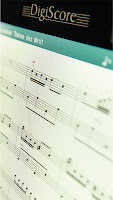
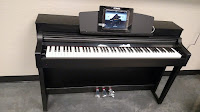
For the average beginner or family who wants a very nice piano in a reasonable price range they can
grow with while keeping
everyone motivated and interested, the Roland HPi50e sould be a very good option. Another downside that I see with this piano is that it is
offered in just one color (satin rosewood). I wish Roland had offered it in
other color finishes (black, white, polished, etc) but for what it is
and what it does, that’s just a relatively small complaint. It looks
good, sounds good, plays good, has tons of cool stuff in it, and makes
you feel good, and that’s what it’s really all about…feeling good when
you practice and when you play…and the HPi50e can do that quite well. *I think it is important to note that the HPi50e has been out for a number of years at this point and is fairly old technology, and the proprietary built-in display screen is not what a lot of people are looking for anymore. That built-in display screen with the built-in software features is great in the beginning but after awhile you may grow tired of those limited features and it cannot be upgraded or updated like a few new model digital pianos can. As an example, these days the piano that seems to be getting a lot of attention is the new 2018 model Yamaha CSP150 and CSP170 (left pic). Instead of using a built-in display screen, you just connect your iPad to the piano and the iPad becomes the display screen and the software is in a proprietary app that Yamaha and Apple have created to give the user hundreds of sounds, interactive accompaniments, and educational lessons in an operational format that is intuitive and more extensive because of the unlimited capabilities of the iPad touch screen instead of a hardware non touch-screen built into the Roland HPi50e. The advantages of newer digital piano technology using an iPad far surpass the older technology which required everything to built into the digital piano itself. iPad’s are easily replaceable and apps are upgradable which is not true of the Roland HPi50e. So I wanted to make that clear to my readers that there may be better alternatives in the newer digital pianos not only with regard to the “fun and educational” features, but also concerning better key action, piano sound, and pedaling in the newer models. Please read my review of the new Yamaha CSP150/170 to learn more: Yamaha CSP150/170 Review
If you want more info on new digital pianos and LOWER PRICES than internet discounts, please email me at tim@azpianowholesale.com or call direct at 602-571-1864.





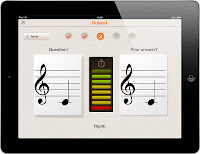










Many thanks for this comprehensive review on the hpi50e. Is there much difference between this and the hpi 7 which sells for more ?
Thank so much for this detailed review. Since I don't have the money for this model I thought about buying the HP506, just connect my IPad to it and download the "Piano Partner" and "Air Performer". Would I get about the same funktions like with the HPi 50e?
similar but not the same. Roland does use a proprietary software package not found on iPad apps and it offers unique educational and fun features.
I am a school music teacher and need a piano that will allow us to record accompaniments and adjust those recordings (fix wrong notes, change tempos, etc.). We use the accompaniments for rehearsals and concerts. Would this piano be a good choice?
how much does this model go for?
depends on where you live, who the local dealer is, and product availability. I stated the average US discount price on my review so that info is there. If you want more detailed price info then you may email me directly
Hi Tim, thanks for the review. I have two questions if you don't mind.
Can you confirm that the Roland ipad apps (Piano Partner etc) work with the HPi-50e? It is not listed in the supported pianos on the Roland website.
What are the differences between the HPi-50e and the HP506? I know that the HP506 is discontinued, but I am trying to understand where the HPi-50e fits in the Roland piano lineup as far as the quality of action, speakers and other non-interactive features are concerned.
Thanks
Tim, The Piano Partner app, etc, will work on the HPi50e and you can use an optional WiFi adapter to connect the piano to an iPad. The HP506 and HPi50e are the identical piano except for the built in large display screen on the HPi50e, control panel on the piano, and of course all the extra functionality of the HPi50e which is significant. The piano sound, key action, speaker system, and pedaling is the same between the two models. If you want more info or want to know about lower discount pricing on these pianos, please contact me by email.
Hi Tim,
I started playing piano with a Casio Privia PX-150 keyboard 2 years ago. I still have problems with maintaining Rhythm. Would buying a Roland HPi-50E help me with my exercises ? Could I take put my DOZEN A DAY exercise books into this piano, have the piano format the music into readable sheet music displayed on its screen, and then when I play, help with my playing ?
no it cannot do that unless the files are MIDI